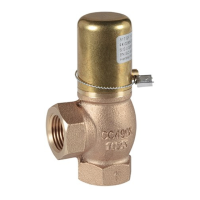Installation & Operation Manual
Proven Quality since 1892
ECON safety valves Fig. 512, 517 and 518 www.eriks.com
Rev. 1
7. Installation
During the assembly of the ECON safety valves, the following rules should be observed:
- make sure before an assembly that the safety valves were not damaged during the transport
or storage.
- make sure that the applied safety valves are suitable for the working conditions, medium used
in the plant and the right system connections, according to pressure and temperature limits as
per the tag plate.
- the interior of the safety valve and pipeline must be free from foreign particles.
- before plant startup, especially after repairs carried out, flash out the pipeline, before installing
the safety valves.
- safety valves have to be installed with the spring bonnet vertically upward
- the body part which contains the spring and the adjusting spring, may not be insulated;
otherwise the spring gets to warm.
- the inlet line should be as short as possible; pressure drop in inlet line must be regarded (fi
regarding ISO 4126-9)
- an outlet line can be mounted at the outlet of the safety valve in order to discharge the
medium to a safe location. For liquids the outlet line should be sloped so the liquid is drained
by gravity . Gases and vapors can be evacuated by a rising outlet line.
- Outlet line must be sized in order to restrict the built-up back-pressure (maximum allowed
built-up back pressure: 15% of set pressure).
- when used with steam or other condensable gases, the outlet line must be executed with a
condensate drain
- it is not allowed to use isolating valves in the in- and/or outlet line. In case isolation of a safety
valve is wanted, only specific solutions are allowed, for instance a change-over-valve for
safety valves.
- excessive vibrations, damaging transverse, bending and tensional forces on inlet/outlet line
and on the safety valve itself must be avoided.
- bolted joints on the pipeline must not cause additional stress resulted from excessive
tightening; the user shall select proper bolts and gaskets according the working temperature,
working pressure and medium.
8. Maintenance
Before starting any service jobs, make sure that the medium supply to the pipeline is cut off,
pressure was decreased to ambient pressure, the pipeline is completely cleaned and ventilated
and the plant is cooled down. Always keep safety instructions in mind and take all personal safety
precautions.
During maintenance, the following rules should be observed:
- always keep personal safety precautions in mind and always use appropriate protection
e.g. clothing, masks, gloves etc.
- be alert that the temperature still can be very high or low and can cause burns.
- check the safety valve on all possible leaking possibilities.
- check if all bolts and nuts are still fastened.
- After installation, the safety valve should be checked and maintained periodically at least
every 3 months, depending on the medium.
-
The safety valves can’t be operated, because they are working on the force executed by the
medium pressure.
If testing is necessary according international and/or national regulations for the concerned
installation (for instance steam), the safety must be executed with a lifting device, like lever or
lifting knob.
For safety valves with lifting device, manual operation is possible at operating pressure ≥ 85% of
the set pressure. Manual operation can be done to test the safety valve or when leakage is
detected at the outlet of the safety valve.

